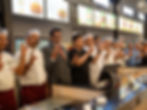5 Steps to Keep Workplace F&B Menus Fresh: A Framework for Admins
- Vanshika
- Sep 24
- 5 min read

You provide safe, healthy meals every day—yet employees still don’t look excited about lunch. Why?
A workplace cafeteria is no longer just about serving just healthy meals—it’s about creating an experience that fuels people, builds trust, and caters to diverse needs. To achieve this, organisations must go beyond surface-level offerings and think deeply about what their employees want and how food impacts their day.
We understand the challenges in keeping workplace F&B programs vibrant for a diverse workforce. With10+ years of expertise in workplace dining, we have curated this blog highlights the key elements that make meal planning both exciting and employee friendly.

Let’s take a deeper look at the 5-step approach we follow to ensure every dish we serve is meaningful.
1. Understanding Your Employees
Every workforce is different. From dietary preferences to cultural sensitivities, the first step is listening. Food programs should be designed for all user types: vegetarians, non-vegetarians, health-first eaters, indulgence seekers, and everyone in between.
It begins with asking ourselves the right questions:
How many bachelors are working here?
Can we create food that gives them a feeling of home away from home?
How many employees have flown down from their hometowns?
Do we have a diverse enough regional menu to cater to different regional palates?
What do employees’ food spending habits look like?
Are they seeking cost-effective cafeteria meals, or are they willing to pay extra for premium buffet?
What are their dietary preferences?
Do we know how many prefer vegetarian, vegan, high-protein, or low-carb meals?
Apart from the insightful questions stated above, here’s a list of the top 10 basic questions we must ask employees of our clients:
Which state are you from?
What best describes your current living arrangement?
Which meals would you like to eat at the office?
What are your daily food habits like?
What kind of food do you enjoy most at work?
How often do you bring food from home?
How health-conscious are you when it comes to office food?
Do you prefer branded food outlets in the cafeteria?
How much would you spend on one meal at the cafeteria?
Other than food, what other elements do you look for in a workplace cafeteria?
2. Menu Engineering
Once we know what employees want, we should put our culinary hat on. It’s time to engineer menus across 12+ parameters, from natural colour patterns and balanced accompaniments to cost efficiency, seasonal relevance, and dietary inclusivity.

Here’s how it should be done:
1. People First
Demographic Insights: Menus are designed to respect diverse food cultures and eating habits.
Employee Inputs: Preferences and feedback shape menu iterations to reflect real needs.
Admin Feedback: We align with admin teams for insights into employee satisfaction and operational priorities.
2. Culinary Selection
Seasonal Food: Fresh fruits and vegetables keep meals healthy, relevant, and cost-effective.
Cuisine Curation: A thoughtful blend of regional and global dishes caters to varied palates.
Perfect Pairings: Meals are completed with accompaniments that balance nutrition and enhance taste.
3. Sensory Variety
Diverse Ingredients: Avoids repetition and keeps menus engaging.
Balanced Flavours: Ensures sweet, spicy, and tangy notes complement each other.
Variety in Colour: Visually appealing plates encourage better meal uptake and satisfaction.
4. Operational Fit
Pricing Consideration: Menus are guided by market analysis and budget alignment, ensuring cost efficiency without compromise.
Vendor Expertise: Leveraging our vendor partners’ culinary strengths and kitchen capabilities guarantees consistency in delivery.
5. Beyond the Plate
Festive-Themed Menus: Celebrate occasions and cultural moments with immersive food experiences.
Surprise Counters & Engagements: From live counters to non-food activations, we keep the cafeteria experience dynamic and fun.
Here’s a sample menu to show you how we bring variety to life.
Beyond this, we design festive-themed menus to create immersive celebrations, along with surprise counters, non-food engagement activities, and more.
3. Vendor Curation

Great food starts with the right food partners. From sourcing regional specialties to delivering diet-specific meals, the curated vendor ecosystem should make sure every menu idea translates seamlessly into reality.
The best strategy to have great menu curation is by having a good mix of vendors across local favourites, QSRs, and gourmet specialists—so employees always have something new to look forward to without compromising on quality or consistency.
Local Heroes: Regional favourites that bring authenticity to the table. Whether it’s a beloved dosa spot in Bengaluru or a legendary chaat vendor in Delhi, we should tap into what people love locally to make employees feel at home.
Large QSR Brands: We should collaborate with well-recognized QSR brands—names like Domino’s and Taco Bell that employees instantly connect with and enjoy. This ensures familiarity and comfort for employees who like having recognizable options on the menu.
Gourmet Brands: Premium names like ITC, who operate through cloud kitchens, restaurants, or by providing their in-house culinary expertise. These elevate the food program by bringing a premium touch into workplace cafeterias.
(Curious about how we evaluate and onboard these vendors? Read our detailed blog on vendor management here.)
4. Consistent & Progressive Service

Food experiences shouldn’t be one-off events. We should focus on consistency ensuring that once the service starts, employees enjoy the same high-quality meals day after day.
Here’s how we can ensure consistency:
Implementing onboarded vendors at the right client locations to offer diverse food options
Regular HSEQ audits for vendors to ensure they meet strict health, safety, environment and quality standards
Tracking of detailed operational checklists and stringent adherence to cafeteria compliance
Continuous feedback loops gathering inputs from cafeteria management, operations teams, and consumers (more on this in the next point).
5. Closed-Loop Feedback

The cycle comes full circle with feedback. Following simple yet complex process of regularly taking input from employees, acting on it, and communicating the changes back to them is all what it takes to keep your employees happy. This loop builds trust and makes employees feel heard, ensuring they’re not just eating at the cafeteria but actively shaping it.
The cycle comes full circle with feedback but not just in a generic way. At SmartQ, we actively capture three types of feedback:
Cafeteria management feedback from Workplace Experience/ Admin team on day-to-day functioning, like vendor
Operations team feedback on backend processes, including food preparation, hygiene, and service standards.
End-user (employee) feedback on taste, freshness, quality and overall dining experience.
Our central team reviews all this feedback, identifies patterns, and works with vendors and operations to implement improvements. Most importantly, we close the loop by communicating these changes back to the consumer.
At the end of the day, a great cafeteria isn’t just about feeding people. It’s about creating an experience that works for everyone. By following these five steps, we make sure the needs of every employee, from interns to CXOs, are met.
The cafeteria becomes more than a place to eat. It becomes a shared space where food brings people together and culture comes alive.
Now that you’ve seen what goes into creating diverse menus that employees actually enjoy, here’s another question:
Is good food alone enough to keep employees happy?
In today’s talent market, the answer is no.
Companies need stronger employee benefits to truly elevate workplace happiness and tackle the talent crunch. We’ll explore this in our next blog.